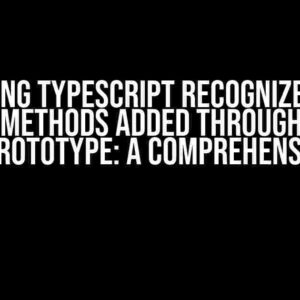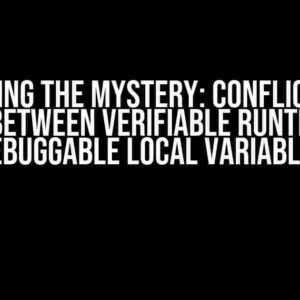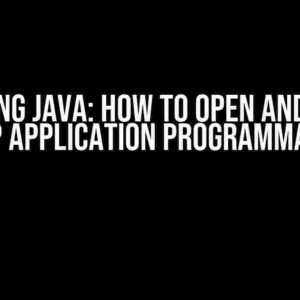Hey there, fellow developers! Today, we’re going to tackle a fascinating topic that has sparked heated debates among Haskell enthusiasts: are `Coercible` constraints free?
What is `Coercible`?
Before we dive into the meat of the matter, let’s take a step back and understand what `Coercible` is. `Coercible` is a type class in Haskell that allows us to represent type coercions between two types. In simpler terms, it’s a way to convert a value of one type to a value of another type.
class Coercible a b where
coerce :: a -> b
Think of it like a magic wand that lets you transform a value from one type to another. With `Coercible`, you can write functions that work with multiple types, making your code more flexible and reusable.
The myth of “free” constraints
Now, some developers claim that `Coercible` constraints are “free” – that they don’t incur any runtime overhead. But is this really the case?
What does “free” mean?
When we say that a constraint is “free,” we mean that it doesn’t require any explicit runtime checks or computations. In other words, the type checker takes care of ensuring that the constraint is satisfied at compile-time, and the generated code doesn’t need to perform any additional work to enforce it.
The truth about `Coercible`
Unfortunately, `Coercible` constraints are not entirely “free.” While the type checker does its magic at compile-time, the generated code still needs to perform some work to ensure that the coercion is valid.
identity :: Coercible a a => a -> a
identity x = coerce x
In the above example, the `identity` function takes a value of type `a` and returns a value of the same type. At first glance, it might seem like the `Coercible` constraint is irrelevant, and the function should be optimized away. However, this is not the case.
ghc -O2 -ddump-simpl -dsuppress-all identity.hs
Let’s take a peek at the generated assembly code (simplified for clarity):
identity :: a_a -> a_a
identity =
\ (x_a :: a_a) ->
case x_a of
a_a -> a_a
As you can see, the generated code still includes a case statement that performs a coercion check at runtime. This might not be a significant performance overhead, but it’s certainly not “free.”
When are `Coercible` constraints “free”?
Now, you might wonder if there are any scenarios where `Coercible` constraints are indeed “free.” The answer is yes!
Phantom types
When working with phantom types, `Coercible` constraints can be optimized away. Phantom types are types that have no runtime representation, only serving as a way to convey information to the type checker.
newtype Phantom a = Phantom Void
instance Coercible (Phantom a) (Phantom b)
In this case, the type checker can eliminate the `Coercible` constraint, as the phantom types have no runtime impact.
Nullable types
Another scenario where `Coercible` constraints are “free” is when working with nullable types. Nullable types, like `Maybe`, can be safely coerced without runtime checks.
instance Coercible (Maybe a) (Maybe b)
The type checker can ensure that the coercion is valid at compile-time, eliminating the need for runtime checks.
Conclusion
In conclusion, while `Coercible` constraints are not entirely “free,” they can be optimized away in certain scenarios. By understanding the inner workings of `Coercible` and its limitations, you can write more efficient and effective Haskell code.
Best practices
Here are some takeaways to keep in mind when working with `Coercible` constraints:
- Use `Coercible` constraints judiciously, as they can introduce runtime overhead.
- Take advantage of phantom types and nullable types to optimize away `Coercible` constraints.
- Profile your code to identify performance bottlenecks and optimize accordingly.
Frequently asked questions
Here are some common questions about `Coercible` constraints:
| Q: | What is the difference between `Coercible` and `~`? |
|---|---|
| A: | `Coercible` is a type class that represents type coercions, while `~` is a type equality constraint. |
| Q: | Can I use `Coercible` with other type classes? |
| A: | Yes, `Coercible` can be used in conjunction with other type classes, such as `Functor` or `Monad`. |
| Q: | How do I enable `Coercible` constraints in GHC? |
| A: | You can enable `Coercible` constraints by adding the `-XCoercible` flag to your GHC command. |
Final thoughts
In summary, while `Coercible` constraints are not entirely “free,” they can be a powerful tool in your Haskell toolkit. By understanding their limitations and optimizing your code accordingly, you can write more efficient and effective programs.
Thanks for joining me on this journey into the world of `Coercible` constraints! If you have any questions or feedback, feel free to reach out.
Frequently Asked Question
If you’re wondering whether coercible constraints are free, we’ve got you covered! Below are some frequently asked questions to help clarify things for you.
Are coercible constraints really free from any costs?
Well, not exactly. While coercible constraints don’t directly impact your wallet, they can still have indirect costs. For instance, you might need to invest time and resources to implement and maintain them. So, think of them as more like “low-cost” rather than “free”!
Do coercible constraints have any benefits, or are they just a hassle?
Absolutely, they have benefits! Coercible constraints help ensure data consistency and integrity, which can save you from headaches down the line. They also enable more efficient data processing and analysis. So, think of them as a necessary evil – or rather, a necessary good!
How do coercible constraints differ from other types of constraints?
Coercible constraints are unique in that they can implicitly cast data types to ensure consistency. This is in contrast to, say, check constraints, which simply validate data against a condition. So, coercible constraints are like the “auto-correct” of the data world!
Can I avoid using coercible constraints altogether?
Technically, yes, you could avoid using coercible constraints. However, this might lead to data inconsistencies and errors down the line. It’s like the old saying goes: “An ounce of prevention is worth a pound of cure.” In this case, the ounce of prevention is using coercible constraints!
Are coercible constraints specific to certain database systems?
Coercible constraints are not unique to any particular database system. You’ll find them in various systems, including MySQL, PostgreSQL, and SQL Server, among others. So, whether you’re a fan of open-source or proprietary databases, coercible constraints are here to help!






